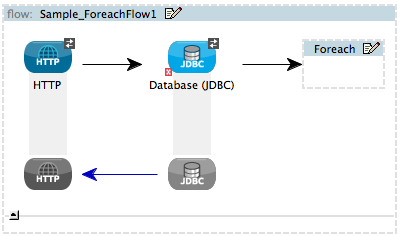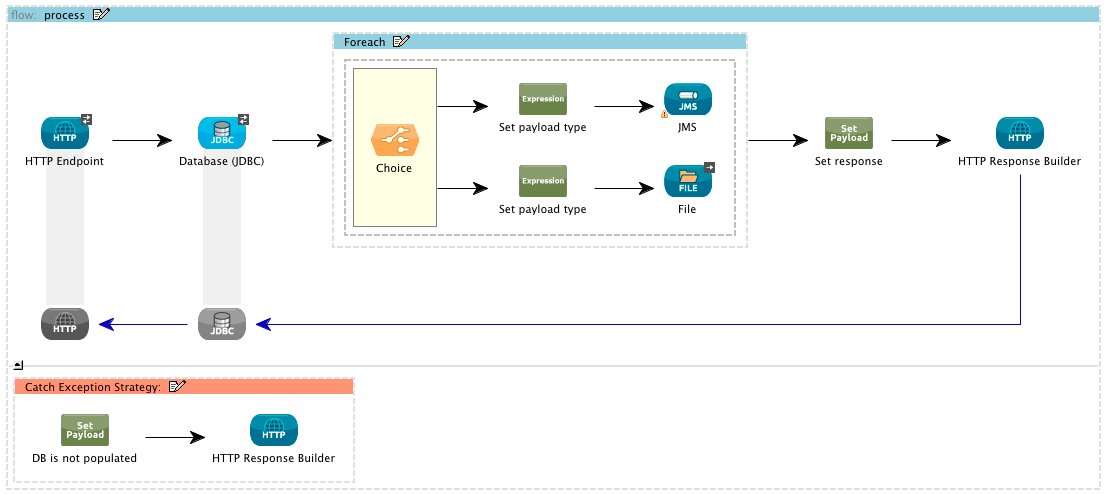
Foreach Scope
Overview
This scope simplifies the splitting and aggregation of message collections.
Typically, a flow that processes messages containing a collection of elements must use one flow control to split the collection into individual elements, which it processes iteratively, then use another flow control to re-aggregate the elements into a new collection so they can be passed out of the flow. Several of Mule ESB’s flow controls support such splitting-and-re-aggregation, but even when carefully chosen for a specific task, they cannot match the convenience of the Foreach Scope.
This use of splitter and aggregator pairs also presents several potential limitations:
-
Under some circumstances, splitting a message collection into pieces can cause certain vital bits of XML — metadata in the header or footer, for example — to be dropped from the re-aggregated XML.
-
When you split certain collection types — Java, for example — into many pieces for processing, the collection may be re-aggregated into a different collection type — MuleMessageCollection, for example. (As a result, you may need to add extra flow steps to transform the processed message collection back into its original collection type.)
-
When you split, process, or aggregate a message collection, you must choose among several splitter and aggregator types. Sometimes, it proves difficult to determine which splitter/aggregator combination best suits your message processing needs.
Foreach provides several advantages over splitter-aggregator pairs:
-
Foreach splits collections into elements, then processes them iteratively without losing any of the message payload.
-
After Foreach splits a message collection and processes the individual elements, it doesn’t re-aggregate those individual elements into a MuleMessageCollection; rather, it returns a reference to the original message. (This results in "Java in, Java out" rather than "Java in, MuleMessageCollection out").
-
The Foreach scope is versatile; it can iteratively process elements from any type of collection, including maps, lists, arrays, and MuleMessageCollections.
-
The Foreach scope can split and process collections of elements that are not part of the message payload. For example, Foreach can process message property collections (metadata) from the message header.
Configuring Foreach
-
Drag and drop the Foreach scope icon from the Studio palette onto the Message Flow canvas.

-
Double-click the icon to open the Scope Properties panel.
-
On the General tab, enter a Display Name for the scope, and — according to the requirements of your context — configure any of the four Attributes.

Attribute Default Value Description Collection
(Optional) Enter an expression that tells Foreach where to find the data it must split and process. For example, enter an expression that instructs Foreach to split and process a collection from the header section – rather than the payload. Unless this field specifies otherwise, Foreach assumes that the message payload is the collection.
Counter Variable Name
counter
(Optional) Enter a name in this field to label the variable that Foreach uses to record the number of the elements it has processed. If your collection already uses the label
counterfor another variable, enter a different label for the Counter Variable Name, such asindex.Batch Size
1
(Optional) Enter an integer to indicate the number of elements in each batch that Foreach processes. Potentially, these batches promote quicker processing. For example, if a collection has 200 elements and you set the batch size to 50, Foreach will iteratively process 4 batches of 50 elements.
Root Message Variable Name
rootMessage
(Optional) Enter a name in this field to label the variable that Foreach uses to reference the complete, unsplit message collection. If your collection already uses the label
rootMessagefor another variable, enter a different label for the Root Message Variable Name. -
Click the Documentation tab to add notes about the scope, if you wish, and then click OK to save your changes.
-
Drag building blocks from the palette into the Foreach scope to build a subflow that will process each element within the message collection. The Foreach scope can contain any number of message processors as well as references to child flows.
The only type of message processor you cannot drag into a Foreach scope is an inbound endpoint.
If you drag a two-way endpoint into a Foreach scope, Mule automatically converts it to an outbound-only endpoint.
Foreach Error Handling
The exception strategy defined for your flow handles all the exceptions thrown within the Foreach scope and its subflow. (If you have not explicitly defined an exception strategy for your flow, Mule implicitly applies the default exception strategy handles exceptions.) If a message in a collection throws an exception, Foreach stops processing that collection and invokes the exception strategy.
For example, Foreach throws an IllegalArgumentException whenever two conditions hold true:
-
it receives a message payload that is not a collection
-
you have not identified a message collection outside the message payload (defined by entering an expression in the Collection field in the Attributes section of the Foreach General tab)
Example
The following example illustrates a flow that uses Foreach to add information to each message in a collection.
The HTTP endpoint receives a request from a client, then queries a JDBC database, where a table indicates the model names and the model years of various cars. Foreach breaks the collection (the table) apart into a list of elements (rows), each of which contains information such as about individual elements (maps) model:'ford sierra', model_year=1982}}. Foreach sends each element through the message processors in its subflow.
The flow adds a new entry to each element’s map; if the model year is less than 2001, Mule adds type='20th century car', then sends the element to the JMS endpoint; otherwise, Mule adds type='21st century car' and sends the element to the File endpoint. Foreach returns a collection at the end of the flow and sends it to the transformer.
This particular example replaces the main flow’s default exception strategy with a custom Catch Exception Strategy that leverages the Set Payload and HTTP Response Builder building blocks.

Full Example Code
<?xml version="1.0" encoding="UTF-8"?>
<mule xmlns="http://www.mulesoft.org/schema/mule/core"
xmlns:http="http://www.mulesoft.org/schema/mule/http"
xmlns:file="http://www.mulesoft.org/schema/mule/file"
xmlns:jdbc="http://www.mulesoft.org/schema/mule/jdbc"
xmlns:jms="http://www.mulesoft.org/schema/mule/jms"
xmlns:scripting="http://www.mulesoft.org/schema/mule/scripting"
xmlns:doc="http://www.mulesoft.org/schema/mule/documentation"
xmlns:core="http://www.mulesoft.org/schema/mule/core"
xmlns:xsi="http://www.w3.org/2001/XMLSchema-instance"
xsi:schemaLocation="
http://www.mulesoft.org/schema/mule/http http://www.mulesoft.org/schema/mule/http/current/mule-http.xsd
http://www.mulesoft.org/schema/mule/file http://www.mulesoft.org/schema/mule/file/current/mule-file.xsd
http://www.mulesoft.org/schema/mule/jdbc http://www.mulesoft.org/schema/mule/jdbc/current/mule-jdbc.xsd
http://www.mulesoft.org/schema/mule/jms http://www.mulesoft.org/schema/mule/jms/current/mule-jms.xsd
http://www.mulesoft.org/schema/mule/scripting http://www.mulesoft.org/schema/mule/scripting/current/mule-scripting.xsd
http://www.mulesoft.org/schema/mule/core http://www.mulesoft.org/schema/mule/core/current/mule.xsd">
<jdbc:derby-data-source name="Derby_Data_Source" url="jdbc:derby:${app.home}/muleEmbeddedDB;create=true" transactionIsolation="UNSPECIFIED" doc:name="Derby Data Source"/>
<jdbc:connector name="JDBCConnector" dataSource-ref="Derby_Data_Source" validateConnections="true" queryTimeout="-1" pollingFrequency="0" doc:name="JDBCConnector">
<jdbc:query key="allcars" value="SELECT * FROM cars"/>
</jdbc:connector>
<jms:activemq-connector name="JMSConnector" doc:name="Active MQ"/>
<flow name="process" doc:name="process">
<http:inbound-endpoint exchange-pattern="request-response" host="localhost" port="9091" path="process" doc:name="HTTP Endpoint"/>
<jdbc:outbound-endpoint exchange-pattern="request-response" queryKey="allcars" responseTimeout="10000" mimeType="text/plain" queryTimeout="-1" connector-ref="JDBCConnector" doc:name="Database (JDBC)"/>
<foreach doc:name="Foreach">
<choice doc:name="Choice">
<when expression="payload['MODEL_YEAR'] &lt; 2001">
<processor-chain>
<expression-component doc:name="Set payload type">payload['TYPE']='20th century car'</expression-component>
<jms:outbound-endpoint queue="in" doc:name="JMS"/>
</processor-chain>
</when>
<otherwise>
<processor-chain>
<expression-component doc:name="Set payload type">payload['TYPE']='21st century car'</expression-component>
<file:outbound-endpoint path="/tmp" responseTimeout="10000" doc:name="File"/>
</processor-chain>
</otherwise>
</choice>
</foreach>
<set-payload value="#[payload.size()] cars where processed: #[payload]" doc:name="Set response"/>
<http:response-builder contentType="text/html" doc:name="HTTP Response Builder">
<parse-template location="foreach_info.html" doc:name="Parse Template"/>
</http:response-builder>
<catch-exception-strategy doc:name="Catch Exception Strategy">
<set-payload value="You need to populate the Database first" doc:name="DB is not populated"/>
<http:response-builder status="500" contentType="text/html" doc:name="HTTP Response Builder">
<parse-template location="foreach_error.html" doc:name="Parse Template"/>
</http:response-builder>
</catch-exception-strategy>
</flow>
<flow name="populate" doc:name="populate">
<http:inbound-endpoint exchange-pattern="request-response" host="localhost" port="9091" path="populate" doc:name="HTTP Endpoint"/>
<scripting:component doc:name="Script to populate DB">
<scripting:script engine="Groovy">
<scripting:text><![CDATA[jdbcConnector = muleContext.getRegistry().lookupConnector("JDBCConnector");
qr = jdbcConnector.getQueryRunner();
conn = jdbcConnector.getConnection();
qr.update(conn, "CREATE TABLE cars (model varchar(256), model_year integer)");
qr.update(conn, "INSERT INTO cars values('Ford Sierra', 1982)");
qr.update(conn, "INSERT INTO cars values('Opel Astra', 2001)");]]></scripting:text>
</scripting:script>
</scripting:component>
<set-payload value="Successfully populated the database" doc:name="Set Payload"/>
<http:response-builder contentType="text/html" doc:name="HTTP Response Builder">
<parse-template location="foreach_info.html" doc:name="Parse Template"/>
</http:response-builder>
<catch-exception-strategy doc:name="Catch Exception Strategy">
<set-payload value="DB already populated" doc:name="Database Already populated"/>
<http:response-builder status="500" contentType="text/html" doc:name="HTTP Response Builder">
<parse-template location="foreach_error.html" doc:name="Parse Template"/>
</http:response-builder>
</catch-exception-strategy>
</flow>
</mule>


